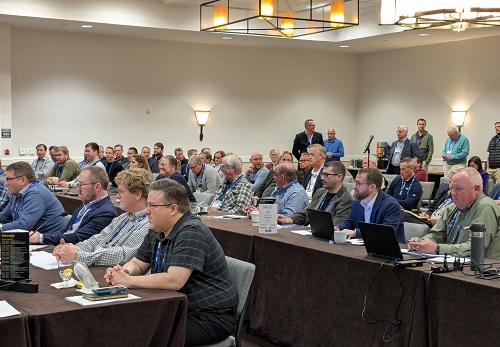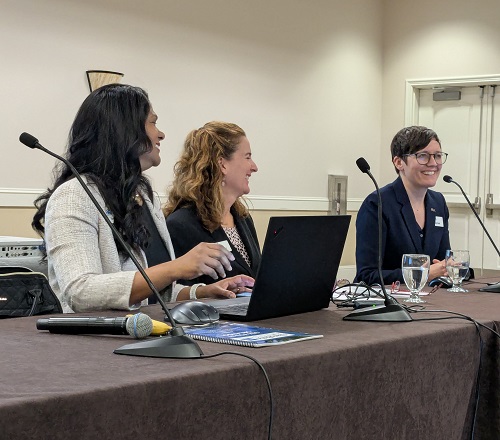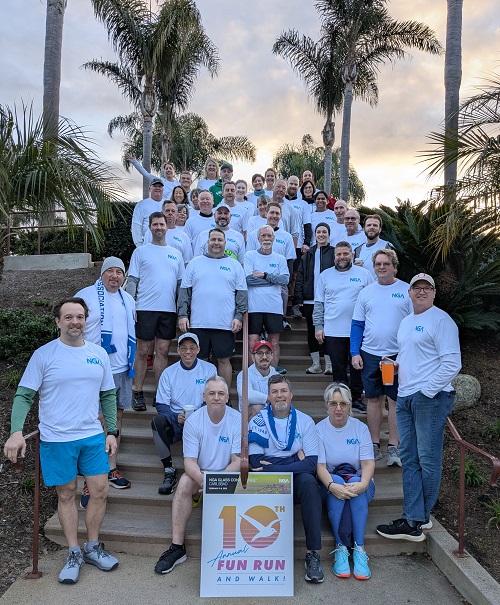
NGA Glass Conference: Carlsbad Feb. 2-5, offered two workshops, the 10th Annual Fun Run, meetings of the Forming, Fabricating and Advocacy Committees, and Volunteer Awards, plus educational sessions covering topics of importance to the glass and glazing industry.
EPA Grant Workshop
The conference kicked off with the optional golf scramble and a special EPA Grant Workshop for members. Urmilla Jokhu Sowell, VP, technical services, and grant consultant Thomas Culp with Birch Point Consulting walked attendees through the key initiatives that would be funded through NGA's EPA grant, and how it will advance sustainability and transparency in the industry.
The demand for EPDs in the glass and glazing industry is rapidly increasing, with architects and general contractors frequently adding them to project specifications or making last-minute requests. For many companies, the ability to provide an EPD is becoming a cost of doing business, as failing to supply one can lead to lost project opportunities. Additionally, green building programs and “Buy Clean” policies are setting stricter requirements for both the number of EPDs required and embodied carbon limits for construction materials. Beyond compliance, EPDs offer significant marketing and promotional benefits, helping architects design for sustainability while also allowing glass manufacturers and fabricators to better understand their internal processes, benchmark performance, and make informed business decisions based on environmental and financial impacts.

Education Sessions
Sessions throughout day 2 of the NGA Glass Conference: Carlsbad focused on the many changes on the horizon—economic conditions, regulatory pressures, rising environmental challenges and so much more. Speakers discussing a variety of topics made it clear that industry adaptability and collaboration are essential for navigating a complex roadmap of economic, environmental and regulatory challenges.
Market Factors to Watch
Katy Devlin, NGA's VP of content and programming, presented Market Factors to Watch in 2025. “There’s so much happening in our industry right now,” she said, noting myriad complexities currently affecting the glass sector, including economic shifts and supply chain issues. She explored how trade dynamics, tariffs and inflation could impact the industry, alongside a promising job market and challenges in labor availability.
Devlin pointed out that despite uncertainties over higher-than-desired inflation—reported at 2.9% for 2024—the U.S. economy remains relatively steady, with job rates exceeding expectations. “The U.S. added 256,000 jobs in December, 2.2 million in all of 2023,” she said, providing a contrasting view against the backdrop of brutal economic undertows. Yet, she also noted an alarming trend: “finding labor has been a challenge for many people,” which highlights a critical obstacle in workforce sustainability.
New Initiatives
Helen Sanders, general manager at Technoform North America, presented Market Trends & New Initiatives, underscoring the importance of high-performance facades and fenestration systems in modern architecture, especially in light of climate change. “We know Europe already makes high-performance windows and fenestration,” Sanders said. “We must figure out how we change our local supply chains to be more competitive... I think this is a real risk for our local market.”

The conversation also identified barriers like cost and market dynamics that hinder adoption, along with a call for increased education and awareness among stakeholders. Overall, Sanders’ presentation stressed the need for better marketing strategies to promote high-performance products as economically viable choices, focusing on fostering consumer understanding of their benefits and long-term cost savings.
Sustainability Legislation
Federal agency expert and sustainability architect Lance Davis, FAIA, LEED Fellow, MSU Fellow discussed how sustainability legislation influences architectural design and glazing standards in federal buildings. He highlighted the federal government’s substantial investment in sustainable practices and the integration of energy-efficient systems. “Right now, we have a requirement that federal buildings being constructed must have 90% fossil fuel-free reduction,” Davis said. “That number goes to 100% by 2030.”
Emphasizing the importance of embodied carbon reduction and rigorous building envelope testing, Davis noted that these efforts are crucial as the industry faces strict compliance challenges. His insights called for collaboration between architects, engineers and policymakers to navigate evolving sustainability standards, reinforcing that adhering to these regulations is vital for creating resilient and eco-friendly structures. See a recording of this presentation during our next Thirsty Thursday on February 27.
Industry Advocacy
Laurie Purpuro, NGA’s government affairs consultant, highlighted the complex interplay of U.S. trade policy, legislative priorities and the implications for various industries, particularly the glass and construction sectors, following significant political shifts. The role of tariffs in negotiations and their potential to reshape economic conditions were analyzed, highlighting implications for costs across multiple sectors. The presentation defined a pivotal moment for industries to engage in policymaking actively, ensuring their needs are represented in future legislative agendas concerning trade and economic regulations.
“This is a critical time, if you haven’t already done so, make sure you know your supply chain,” said Purpuro. “Whatever additional costs result from tariffs in the short to medium term... will just simply be a fact of life in the U.S market going forward.”
Building Resilience
NGA code consultant, Thom Zaremba, presented Energy, Structural & Fire Building Codes & Standards Update, which detailed the vulnerability of structures, particularly older buildings, to events like hurricanes and wildfires, emphasizing the inadequacy of current inspection processes. Recommendations for improved resilience included utilizing tempered glass and fire-resistant materials. The session highlighted legislative parallels to Florida’s post-Surfside inspections as necessary models for other disaster-prone regions. Emphasizing proactive measures, Zaremba called on attendees to leverage their influence in advocating for stronger building regulations and safety protocols to shelter communities from future disasters.
Day 2 concluded with the Volunteer Award Dinner. Read about this year's winner, Rob Carlson, and other volunteer honorees.
Committee Meetings and Industry Collaboration
Day 3 of NGA Glass Conference: Carlsbad, NGA committee members, industry partners, subject matter experts and participants discussed challenges centered around sustainability, regulatory compliance, industry standards and improving school security.
Advocacy and Sustainability
Tom Culp from Birch Point Consulting shared insights on Tax Credit 48 and its effect on the industry’s economy, while Urmilla Sowell and Nick Resetar talked about new bills, including a significant measure for school security in Utah. Sustainability was a major focus, with Kayla Natividad from Pilkington North America discussing Product Category Rules and Environmental Product Declarations, highlighting the industry's dedication to eco-friendly practices. Kyle Sword also updated attendees on architectural glass recycling, emphasizing efforts to promote sustainability.
Amy Becker from the Fenestration Glazing Industry Alliance discussed ongoing trends in sustainability and training, including the new Fenestration Masters 3.0 program, which helps individuals deepen their understanding of industry standards and practices.
Forming Committee Meeting
NGA's Georgia Scalfano presented an update on a members-only legislative tracking spreadsheet, which serves as a valuable resource for members, enabling them to stay informed on relevant legislative changes that may impact the industry. Committee Vice Chair Jon Griggs with Guardian Glass led participants through discussion on the availability of resources for state clean initiatives, which help members stay updated on relevant legislation and sustainability practices. The committee also introduced key terminology related to sustainability, such as embodied carbon and operational carbon, encouraging members to familiarize themselves with these concepts. As articulated in the discussion, "The future of our industry hinges on our ability to adapt to sustainability measures," emphasizing the urgency and necessity for innovation in this area.
School Security Workshop
The afternoon session delved into the critical issue of school security—and the confusion surrounding commonly used industry terms—with presentations on new standards for fenestration systems to enhance safety against potential threats. Detailed discussions covered the development of specific testing methods for glass products in active-shooter scenarios, as well as the integration of these safety measures into building codes. Presenters also emphasized the collaboration needed between industry professionals and regulatory bodies to ensure that security considerations are effectively implemented in schools.
#NGAGlassConference
Find live coverage of the conference on LinkedIn, from NGA, and from Glass Magazine Editor, Tara Lukasik.